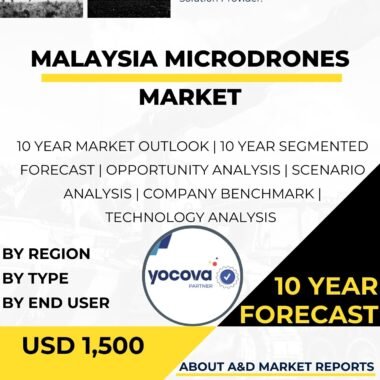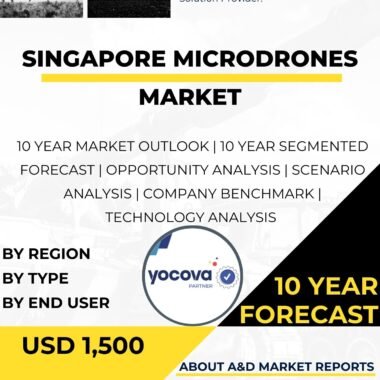Description
The South Korea microdrones market is a rapidly evolving segment of the country’s defense and aerospace industries, characterized by the development and deployment of small unmanned aerial vehicles (UAVs) for a wide range of military and civilian applications. Microdrones, also known as mini-drones or small UAVs, offer unique advantages due to their compact size, agility, and versatility. South Korea’s focus on indigenous development, strategic partnerships, and technological innovation has positioned it as a prominent player in the global microdrones market.
Microdrones have witnessed significant growth and adoption in recent years, fueled by advancements in technology, miniaturization of components, and the increasing demand for low-cost, multi-functional UAVs. These small drones are employed in various sectors, including defense, agriculture, environmental monitoring, surveillance, and disaster response.
Indigenous development has been a key aspect of South Korea’s defense strategy, and the microdrones market is no exception. The country’s defense industry, represented by companies such as LIG Nex1 and Hanwha Aerospace, has made substantial progress in developing advanced microdrone systems tailored to meet the specific requirements of the South Korean military.
In the defense sector, microdrones serve various roles, including reconnaissance, surveillance, intelligence gathering, and target designation. Their small size and low visual and acoustic signatures make them effective tools for covert operations and urban warfare scenarios. South Korea’s military has integrated microdrones into its infantry units, enabling soldiers to conduct real-time reconnaissance and surveillance of the battlefield, enhancing situational awareness and reducing risks to ground forces.
Furthermore, microdrones play a significant role in supporting South Korea’s maritime security. These UAVs are utilized for maritime surveillance, monitoring illegal fishing activities, and patrolling the nation’s coastal areas. Their ability to operate in constrained spaces, such as ports and harbors, makes them invaluable assets for ensuring maritime safety and security.
Beyond the defense sector, South Korea’s agriculture industry has also adopted microdrones for crop monitoring, precision agriculture, and pest control. Equipped with sensors and cameras, these UAVs provide farmers with valuable data on crop health, water stress, and yield potential, enabling more efficient and sustainable agricultural practices.
Additionally, microdrones find applications in environmental monitoring and disaster response. These UAVs can be equipped with specialized sensors to monitor air quality, detect environmental hazards, and assess the impact of natural disasters. During emergencies, microdrones provide real-time situational awareness to first responders, facilitating more effective and timely disaster management efforts.
Moreover, South Korea actively seeks strategic partnerships with international defense and technology companies to enhance its microdrone capabilities. Collaborations with global manufacturers enable technology transfer, joint research, and the integration of foreign systems into South Korea’s indigenous microdrone platforms. These partnerships contribute to the continuous improvement of South Korea’s microdrone technology and reinforce its position in the global defense market.
Furthermore, South Korea’s commitment to innovation and research and development (R&D) has driven advancements in microdrone technology. The country invests in R&D programs to improve the endurance, range, payload capacity, and autonomous capabilities of microdrones. Technological improvements focus on enhancing data processing, communication systems, and artificial intelligence algorithms to enable more autonomous and intelligent operations.
As part of its broader defense industry, South Korea’s microdrones market extends beyond domestic requirements. The country actively exports microdrones and related technologies to other nations, generating revenue and expanding its influence in the global UAV market. Successful exports demonstrate the reliability and performance of South Korean-made microdrones, contributing to the growth of its defense industry.
To ensure optimal utilization and proficiency in operating microdrones, South Korea places significant emphasis on training and skill development for its military personnel and civilian operators. Training programs focus on familiarizing users with the operation, maintenance, and tactical employment of microdrones, ensuring that these assets are effectively deployed in various applications.
Moreover, cybersecurity is a significant consideration in the microdrones market, as these UAVs often incorporate digital components and may be vulnerable to cyber threats. South Korea invests in robust cybersecurity measures to protect its defense infrastructure and ensure the safety and security of microdrone operations.
In conclusion, the South Korea microdrones market is a critical aspect of the country’s defense and aerospace industries. Indigenous development, strategic partnerships, and innovation have allowed South Korea to create advanced microdrone systems that meet the specific needs of its military and civilian sectors. From defense and agriculture to environmental monitoring and disaster response, microdrones provide South Korea with versatile and efficient solutions for a wide range of applications. As the UAV market continues to evolve, South Korea’s dedication to advancing its microdrone technology will remain essential in strengthening its national security and maintaining its position as a prominent player in the global microdrones market.




